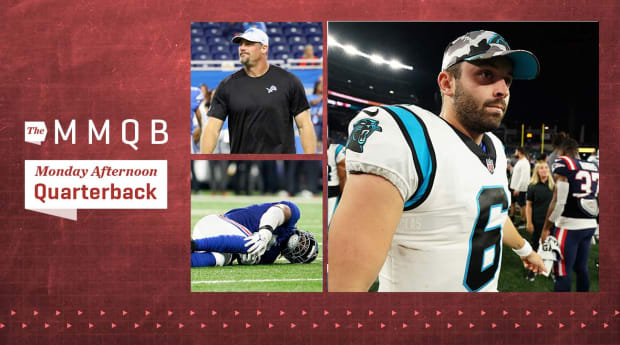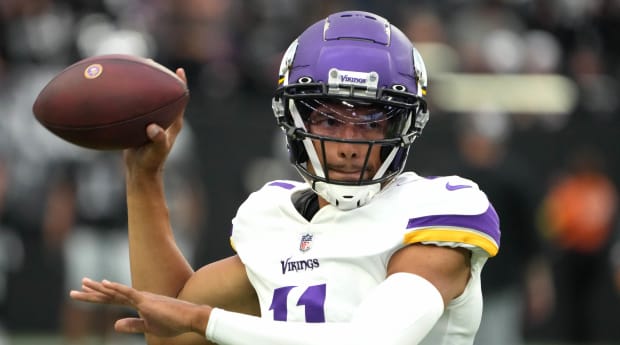
Mayfield: David Butler II/USA TODAY Sports; Campbell: Kirthmon F. Dozier/USA TODAY Network; Thibodeaux: Danielle Parhizkaran/USA TODAY Network
Training camp is, for the most part, over—the veterans are out of the hotel, teams are moving to more regular season-like practice schedules and their openers are three weeks away. So that’s why we’ll start with a big decision being finalized …
And it’s not like that decision was a difficult one for the Panthers—Baker Mayfield built a sizable lead relatively quickly, and held it throughout. But I do think, in a subtle way, it was important that he earn the job the way he did in camp.
The fact is, there are plenty of reps to go around over the summer, and Mayfield was just getting there when the team reconvened in July. Sam Darnold was with his teammates through the spring and had made nice progress in Ben McAdoo’s offense. So doing it this way allowed for Mayfield to win the locker room, put some skins on the wall and earn his place among the team’s leaders.
That started, by the way, almost right away, with Mayfield’s command of the offense coming out of his first couple of weeks as a Panther (a dead period in the calendar during which all the coaches could really do with him was hand him the playbook) and into the first days of camp. It showed his football aptitude, and also his drive to catch up with his teammates mentally with a really big year for him on tap.
Watch Baker Mayfield and the Panthers with fuboTV. Start free trial today.
The Panthers’ logic in getting Mayfield was to get their heads back above water at the most important position on the field. But after a month of working with him, the Panthers have hope that, maybe, Mayfield could give them a little bit more than that.
I love what Lions coach Dan Campbell did with Detroit’s practice on Monday, handing the keys over to the players and letting them set the schedule and run the show for the day. My understanding is most people in the building had no clue he was planning to do it until earlier in the day Monday—he formally presented the concept to the team in a morning meeting.
“It’s their team,” Campbell said via text. “I want them to have ownership in it.”
My sense is, on top of that, the hope would be giving them that ownership now would help accelerate the growth of a really young group. And naturally, players like QB Jared Goff, LB Alex Anzalone, S Tracy Walker, DT Michael Brockers, DE Charles Harris and most of a veteran offensive line, among others, wound up being the ones to take the reins.
Campbell was accompanied on the field by a couple of strength coaches. The rest of his assistants stayed inside, as did most of the front-office people who’d normally be out at practice. And the reaction that came from the players was as expected.
Maybe I’m buying too much into all of this, but I think the Lions are going to be a pretty tough out when the season starts. You can see the togetherness in the group on Hard Knocks—just go watch the way the auditorium exploded during Aidan Hutchinson’s performance at the rookie show—and the composition of the roster, with strength along the lines of scrimmage, sets up the team to be really competitive and steady week to week.
Here’s the play everyone was talking about from Sunday night on Monday morning …
No one wants to see anyone take a hit like Kayvon Thibodeaux did there. But what Thaddeus Moss did wasn’t dirty—cut blocking has been a part of football forever. And part of allowing this sort of block (we can argue about the rules, if you want) is that it’s part of a conscious decision the NFL made to prioritize taking head hits out of the game over low hits.
Now, there are players, Rob Gronkowski being one, who have said they’d rather be hit high than low given what getting taken out at the knees can do to someone’s livelihood. And I understand why guys in their 20s (Gronk was in his 20s when he said it) would see it that way—a player can come back from a concussion in a couple of weeks, whereas a serious knee injury can end a season or even turn a career upside down.
But this is a topic where I agree with the NFL. Decades of data tells us that head injuries will have much more profound long-term damage, and guys who are still playing may not have the perspective to really appreciate that. So the approach, then, has been to take head shots out of the game and be more judicious in legislating punishments for low hits (some have been banned) to leave some strike zone for blockers and tacklers to do their job.
I think if you look at it that way, it does make sense that a hit like Moss’s would be allowed. Lots of those happen in every game without incident. The block that Thibodeaux took just happened to end in an unfortunate way.
One leftover from my trip I wanted to share—Chargers coach Brandon Staley and I discussed his challenge in assimilating a pretty good number of new players in key spots on to the roster, given how complex the scheme is on both sides of the ball (They run a version of Sean Payton’s Saints offense, and then Vic Fangio’s defense).
He didn’t seem overly worried about it.
“Well, we got a lot of really good coaches and we got a lot of good players that've helped,” he said. “You bring in Zion [Johnson] and Jamaree [Salyer] and the fact that you have two stud line coaches in [Brendan] Nugent and Shaun [Sarrett], and then you have this great culture that you've created, like in a year, our O-line has got this really cool culture led by Corey [Linsley]. And now, they're bringing those two guys along so fast and that is amazing.
As we said last week, the Chargers’ goal since Staley was hired was to get bigger across the lines of scrimmage. So they got big people. And, clearly, it was important to make sure that those people will know what they’re doing—and Staley already thinks they do.
Cody Ford took steps forward in Bills camp this summer, but in the end, for a player who’d backslid some over his first three years, and went from starter to backup last year, time finally ran out. Buffalo signed veteran mauler Rodger Saffold in free agency to man one guard spot, then matched a four-year, $17 million offer sheet for Ryan Bates (written by Chicago) in the offseason, which essentially put the writing on the wall.
Ford did get first-team reps early in camp with Saffold nursing a rib injury suffered in a car accident, but when Saffold returned a little over a week ago, he and Bates settled in to take most of the work with the first team, with Ford knocked back down to second team. From there, the prospect of Ford being a backup against this year was
complicated for a couple reasons. One was his own contentment with the situation. Another was his limited position flexibility—he’s put on weight to play guard and wasn’t really an option anymore at tackle.
And so, with Ford in a contract year, there was more value in stocking next year’s draft war chest with another fifth-round pick, with the Bills unlikely to get any comp picks in 2023, then there was in keeping Ford around. For the Cardinals, conversely, giving up the five was logical to get a younger piece on a line that lacks depth in the here and now, is aging all over the place and could have holes to fill in a year or two.

Kirby Lee/USA TODAY Sports
Minnesota’s trade on Monday for Raiders quarterback Nick Mullens, who was probably going to be cut, very much puts Kellen Mond on notice. Normally, a quarterback taken as high as Mond was—he was the 66th pick in the 2021 draft—isn’t let go this quickly. But it’s yet another example of how a regime change can shake up a young quarterback’s career.
If that quarterback is taken in the first round, it often means he’ll have a much shorter leash than he would with the coach and GM that drafted him. If the quarterback went outside the first round, it sometimes can cost a guy his job outright.
Jameis Winston getting back into 11-on-11 work is significant—it happened Monday, and is a big step in that it means the doctors are comfortable with the quarterback having 300-pound defenders around his feet. And while it’s not ideal that Winston didn’t get a full camp in those sorts of settings, this does give him three weeks to ramp up.
“He was good. It was good,” coach Dennis Allen told reporters. “A little rusty, but good to get him back out there and get him back going again. I think anytime we get a guy back from an injury, it’s good to have him back out on the field.”
For what it’s worth, both undefined and Chris Olave have been outstanding of late, so it sure looks like Winston’s walking into a dynamite situation.
Tom Brady is back at practice. Big deal that he missed 10 days? Well … guys in their late 20s get veteran days, so you’d imagine that a guy at 45 can manage a little more than that. Also, if you look, a 39-year-old Brett Favre signed with the Vikings three weeks and five days before their 2009 opener. He had new teammates to learn, a new offense to assimilate to (though he was familiar with OC Darrell Bevell), and an offseason’s worth of rust to knock off. In other words, he was facing more significant hurdles than Brady is.
How’d that turn out? The Vikings started 6–0, finished 12–4, made it to the NFC title game and Favre contended for MVP.
The Raiders’ release of veteran back Kenyan Drake is a sign of two things. One, they couldn’t find a taker for his contract—they did shop him the last couple of days trying to find a trade. And two, they really, really, like what they’ve seen from Ameer Abdullah, who has more or less locked down the passing-down back role that Kevin Faulk, Danny Woodhead, Shane Vereen, Dion Lewis and James White played for Josh McDaniels in New England.
I’d look for it to be Josh Jacobs and Zamir White on early downs, and Abdullah coming in for long-yardage situations in Vegas.
Interesting to see Aaron Rodgers building up Green Bay’s young receivers again after being a little critical of them earlier in camp. And that he did it after Romeo Doubs had some is doubly fascinating, since Doubs—as I’ve heard it, at least—is the young receiver who’s really earned the quarterback’s trust.
Rodgers is pretty sharp. I’d bet he knows he’s gonna need Doubs, and a shaky night over the weekend gave him a nice opportunity to build up the fourth-round pick.







